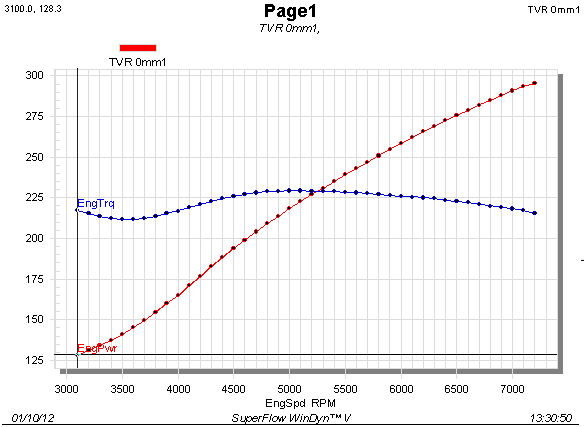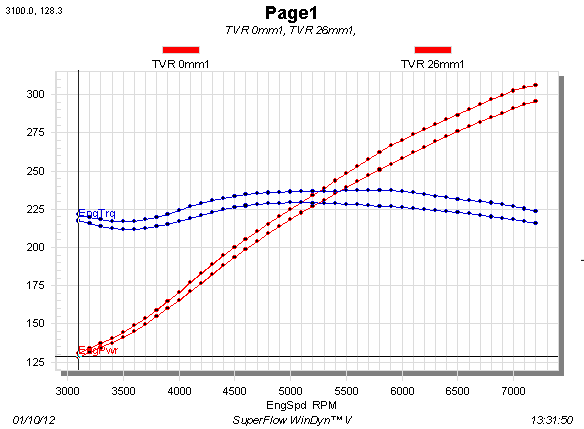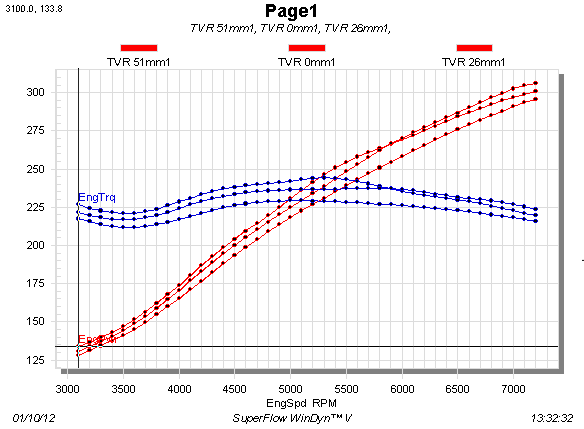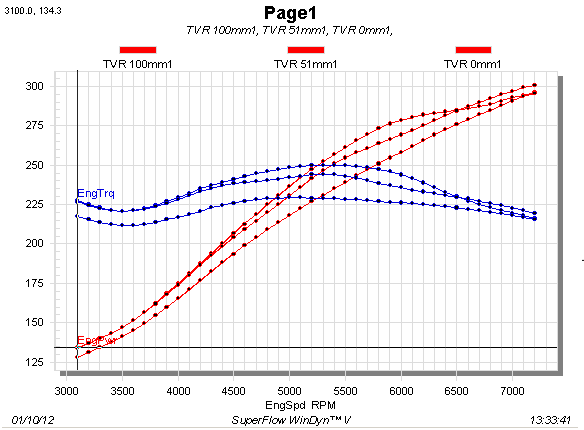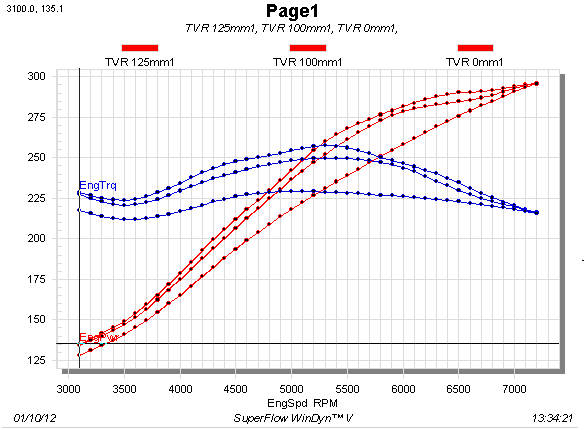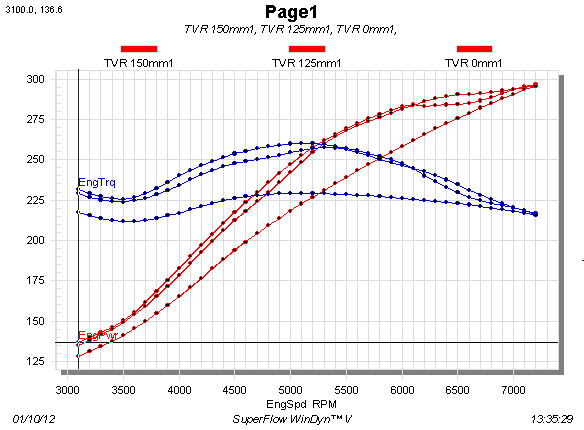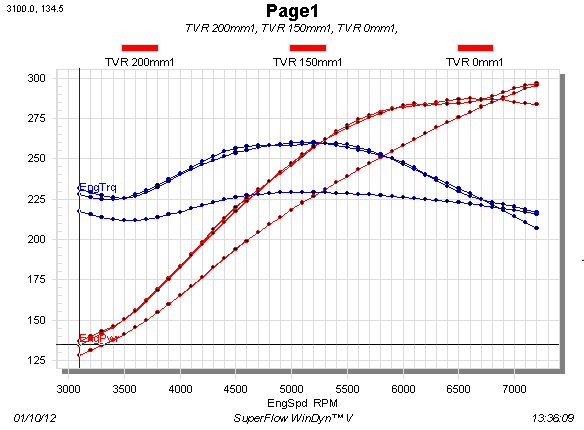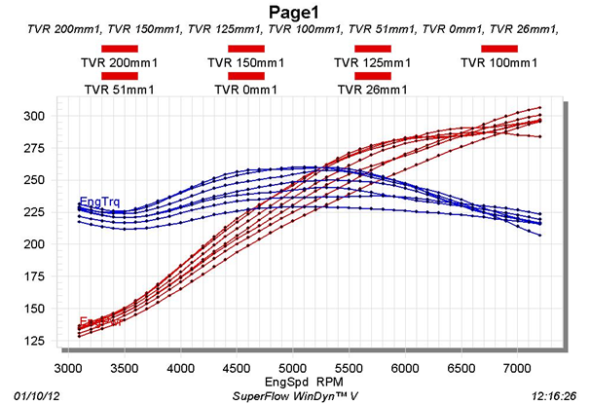Optimizing volumetric efficiency with Inlet runner length “pulse tuning”
Leave a commentNovember 28, 2012 by hotwheels662
Inlet length has a huge effect on the way engine power is produced this is down to the effect commonly known as “pulse tuning, control of pulse frequency to optimize system response”
The easiest way to explain the theory behind pulse tuning is that the engine is basically an air pump, but it is wrong to consider that air flows through the engine, instead it pulses, each cylinder will pulse every 2 revolutions of the crank. These pulses can be used to gain a positive effect, being able to move the point at which the engine makes most power, this can be seen when you blow into a glass bottle full of water, the air molecules inside vibrate creating a high frequency sound, as the quantity of water decreases the frequency at which the molecules vibrate also slows. This is due to the fact that the distance the air has to travel effects the frequency at which the air is vibrating.
In regards to the pulse tuning of an internal combustion engine When the inlet valve opens all the charge down he inlet runners and ports is moving very quickly, when the valve closes its compressed against the back of the valve head. Think of it like a spring, it then pulses back up the port and through the inlet runners until it reaches atmospheric pressure. The pressure here is relatively high compared to the vacuum of the port, so the pressure wave bounces back down the inlet runners and port. If you get it right, just as the inlet valve opens, the air is pushed in, thus increasing volumetric efficiency, which increases torque.
Cars that need a low power bands have long runners as the wave has more time, increasing torque in the low power band 1500-3500 as the torque is needed when cruising and lower engine speeds.
Cars the need high power bands like bike’s and F1 engines have almost no runners, this cause’s a pulse which is most efficient at an higher rpm, creating more torque at higher engine speeds, this would not be practical on a road car as it is impractical to let the engine rev that high due to road speed limits and fuel efficiency.
To put this theory to the test a by testing different inlets lengths on a TVR Speed Six engine, this engine is a n/a, 3600cc of engine displacement straight 6 engine . The engine had been set up on the super flow engine dynamiter prior to testing, allowing for the engine to be run in lab conditions monitoring all engine parameters such as inlet/exhaust gas temps, lambda reading, fuel pressures, etc. The super flow engine dyno mechanism then uses either hydraulic fluid or water to create resistance to the engine’s spinning force. This resistance is continued until the engine’s maximum turning force is measured at every RPM, giving the tester an accurate reading of the engine’s torque and horse power.
The standard air box was then removed allowing access to the engines throttle bodies, 6 different length sets of inlet trumpet had been turned on a lath, allowing for the length from valve to atmosphere to be increased by,
• 0mm
• 26mm
• 51mm
• 100mm
• 125mm
• 150mm
• 200mm
0mm
Firstly to obtain a base figure to start out comparisons the engine was run without any trumpet
295.6bhp at 7200rpm
229.2 ft.lbs at 5000rpm
The torque curve produced by the TVR engine is fairly flat with no real peaks this makes for good drivability and keeps traction loss to a minimum. The power curve rises steadily with no spikes that you may find on a turbocharged engine.
increased to 26mm
A 26mm inlet stack was then added to the throttle bodies to increase the overall intake length by 26mm, this was then run on the engine dynamiter to produce the above result. The 26mm inlet graph has been overlaid on the 0mm setup to allow for comparison of both sets of results.
It outcome of the 26mm stack is quite obvious and has caused power and torque to be increased Farley evenly across the whole power band. Also max BHP has increased from 295.6bhp at 7200rpm to 306.3bhp at 7200rpm this is an increase of 10.7BHP.
Increased to 51mm
A 51mm inlet stack was then added to the throttle bodies to increase the overall intake length by 51mm, this was then run on the engine dynamiter to produce the above result. The 51mm inlet graph has been overlaid with the 26mm and 0mm setup to allow for comparison of the results.
Once again the whole torque curve has increased, but this time the torque starts to tail off at 5800rpm and then begins to follow the torque curve of the 26mm stack. The same applied to the power curve, at 5800rpm the power began to drop off and produce overall less BHP
Length Max power Max torque
0mm 295.6bhp at 7200rpm 229.2 ft.lbs at 5000rpm
26mm 306.3bhp at 7200rpm 237.52ft.lbs at 5700rpm
51mm 300.8bhp at 7200rpm 244.2ft lbs at 5300rpm
A loss of 5.5BHP occurred at max rpm over the 26mm stack, and a gain of 5.2 BHP over 0mm inlet length.
Max torque is still on the increase with gain of 6.68ft lbs occurring 4000rpm earlier than the 26mm inlet stack.
A 100mm inlet stack was then added to the throttle bodies to increase the overall intake length by 100mm, this was then run on the engine dynamiter to produce the above result. The 100mm inlet graph has been overlaid with the 51mm, 0mm setup to allow for comparison of the results.
Length Max power Max torque
0mm 295.6bhp at 7200rpm 229.2 ft.lbs at 5000rpm
26mm 306.3bhp at 7200rpm 237.5.2ft.lbs at 5700rpm
51mm 300.8bhp at 7200rpm 244.2ft lbs at 5300rpm
100mm 296.0bhp at 7200rpm 249.29 ft.lbs at 5300rpm
The 100mm stack yielded a gain of 5.09ft lbs of torque at 5300 rpm this time instead of lifting the entire torque curve it followed the same path as the 51mm stack until 4000rpm then began to rise until 6600rpm when the torque began to tail off. My conclusion for the 100mm stack sharing the same path as the 51mm is because the length has been increased 2 x the pulse reaches the valve on the second wave. There was a loss of 4.08BHP at 7200rpm.
A 125mm inlet stack was then added to the throttle bodies to increase the overall intake length by 125mm, this was then run on the engine dynamiter to produce the above result. The 125mm inlet graph has been overlaid with the 100mm, 0mm setup to allow for comparison of the results.
Length Max power Max torque
0mm 295.6bhp at 7200rpm 229.2 ft.lbs at 5000rpm
26mm 306.3bhp at 7200rpm 237.5.2ft.lbs at 5700rpm
51mm 300.8bhp at 7200rpm 244.2ft lbs at 5300rpm
100mm 296.0bhp at 7200rpm 249.29 ft.lbs at 5300rpm
125mm 296.2bhp at 7200rpm 257.8 ft.lbs at 5300rpm
Peak torque has been increased 8.51 ft.lbs with the overall power curve increased. Torque has also improved thou out the rpm range. The graph shows a smooth power curve, this would improve drive ability and traction created by power and torque spikes.
A 150mm inlet stack was then added to the throttle bodies to increase the overall intake length by 150mm, this was then run on the engine dynamiter to produce the above result. The 150mm inlet graph has been overlaid with the 125mm, 0mm setup to allow for comparison of the results.
Length Max power Max torque
0mm 295.6bhp at 7200rpm 229.2 ft.lbs at 5000rpm
26mm 306.3bhp at 7200rpm 237.5.2ft.lbs at 5700rpm
51mm 300.8bhp at 7200rpm 244.2ft lbs at 5300rpm
100mm 296.0bhp at 7200rpm 249.29 ft.lbs at 5300rpm
125mm 296.2bhp at 7200rpm 257.8 ft.lbs at 5300rpm
150mm 296.9bhp at 7200rpm 260.1 ft.lbs at 5100rpm
The 150mm stack yielded a gain of 2.3ft lbs of torque at 5100 rpm being 2000rpm sooner than the 125mm stack. My conclusion is that the 150mm stack is optimum at 5100rpm due to the increase of length allowing the pulse more distance to travel before reaching the valve opening at optimum time. . There was also a increase of 0.7bhp at max rpm.
A 200mm inlet stack was then added to the throttle bodies to increase the overall intake length by 200mm, this was then run on the engine dynamiter to produce the above result. The 200mm inlet graph has been overlaid with the 150mm, 0mm setup to allow for comparison of the results.
Length Max power Max torque
0mm 295.6bhp at 7200rpm 229.2 ft.lbs at 5000rpm
26mm 306.3bhp at 7200rpm 237.5.2ft.lbs at 5700rpm
51mm 300.8bhp at 7200rpm 244.2ft lbs at 5300rpm
100mm 296.0bhp at 7200rpm 249.29 ft.lbs at 5300rpm
125mm 296.2bhp at 7200rpm 257.8 ft.lbs at 5300rpm
150mm 296.9bhp at 7200rpm 260.1 ft.lbs at 5100rpm
200mm 283.6bhp at 7200rpm 259.7 ft.lbs at 5300rpm
The 200mm stack was the fitted to the engine and a run was completed on the dynamiter this created negative results with a loss of 13.3 bhp at 7200rpm and a loss of 0.4ft lbs at 5300rpm. My conclusion is that the 200mm stack is optimum outside of the rpm range causing the pulse to reach the valve after which is optimum. This is due to the inlet tract being to long allowing for a greater distance for the pulse to travel.
Comparison of all lengths
Length Max power Max torque
0mm 295.6bhp at 7200rpm 229.2 ft.lbs at 5000rpm
26mm 306.3bhp at 7200rpm 237.5.2ft.lbs at 5700rpm
51mm 300.8bhp at 7200rpm 244.2ft lbs at 5300rpm
100mm 296.0bhp at 7200rpm 249.29 ft.lbs at 5300rpm
125mm 296.2bhp at 7200rpm 257.8 ft.lbs at 5300rpm
150mm 296.9bhp at 7200rpm 260.1 ft.lbs at 5100rpm
200mm 283.6bhp at 7200rpm 259.7 ft.lbs at 5300rpm
All the results of the different velocity stacks were now compared and overlaid onto a graph to allow for analysis.
I believe the 26mm stack to be the best due to the biggest increase of power at max rpm this makes for a good engine for a race car due to max power being needed at the straights due to the manner in which the engine is driven.
There was a loss of max torque apparent but this is negotiable due to the great increase in bhp, also the power curve generated was very smooth and looks to be the most effective out of all the different lengths.

